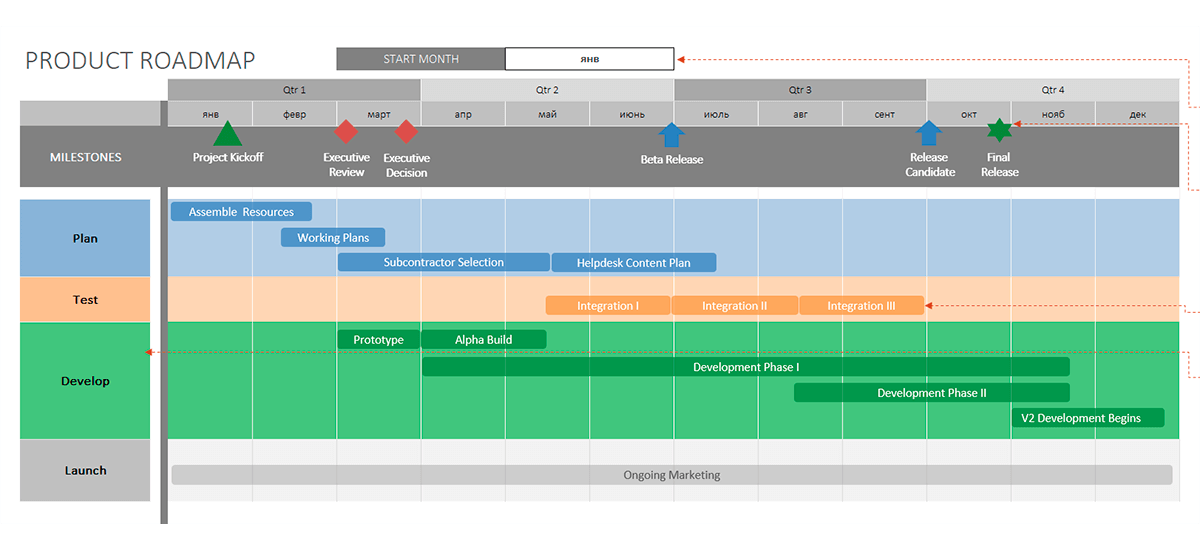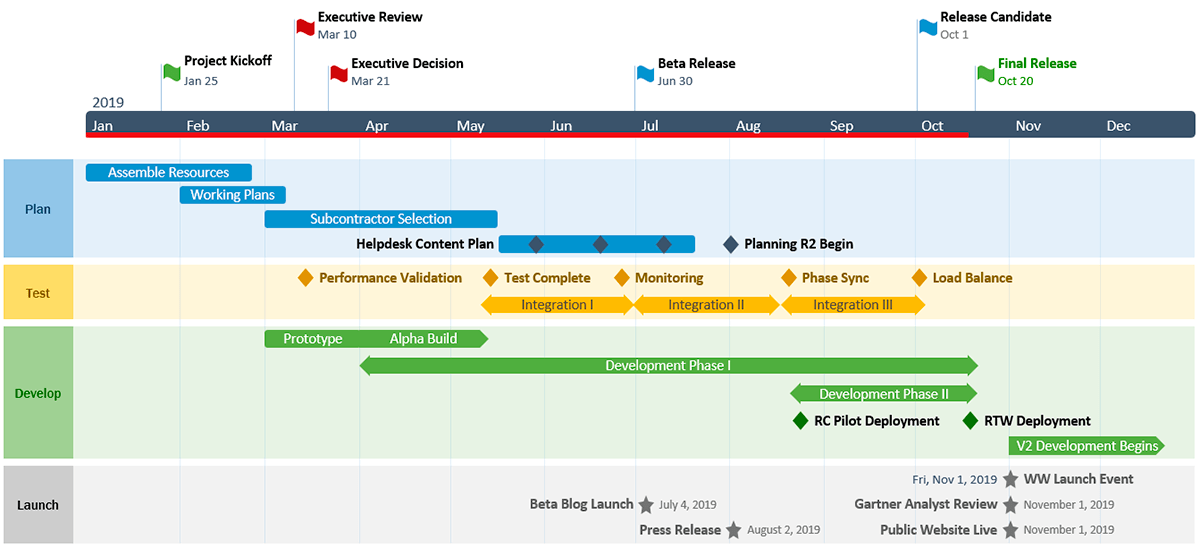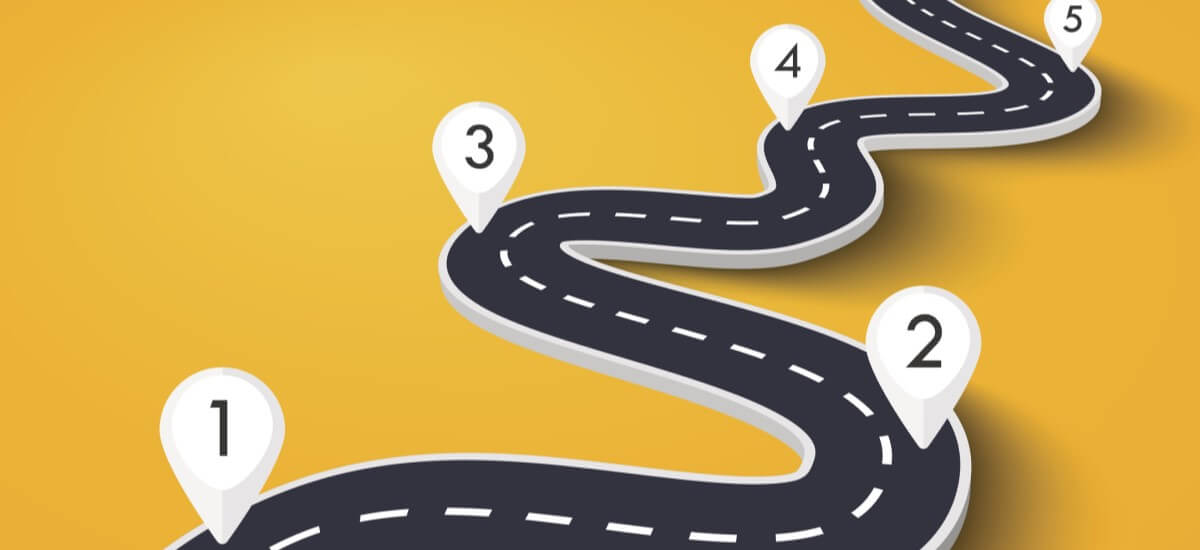A Perfect Roadmap: Short Guide to Success

A high-level visual summary, mapping out the direction of your product over time, is called a product roadmap. It connects and communicates what's and why's behind the project being built. A product roadmap is a strategic document, working together with the product strategy execution plan.
The goals of the product roadmap are the following ones:
- To enlighten the strategy and the general vision;
- Working with the documentation related to the strategy;
- Work coordination with the internal stakeholders;
- Options and scenario planning discussion facilitation;
- Improve the communication process between the external stakeholders and the customers.
Below we will make a brief guide aimed to define all the stages of roadmap creation and will also explore the services which will help to create a roadmap that will rock.
A couple of years ago the casual approach to roadmap creation was just to use PowerPoint or Excel. Now thanks to the numerous services a roadmap creation turned out to be an activity worth spending time on.
Why do we need a roadmap?
To answer this question one should determine what is the main goal of the roadmap as it is. First and foremost, it is to convey the goals of the initial product to be developed. Also, the roadmap underlines the implementation stages, making them vivid not just for the team but for the external stakeholders as well. They include shareholders, partners, and even customers.
In simple words, the product roadmap is a visualization of the main goal to be achieved and all the steps required for it. The features of the product should not be included, just the goal and the steps needed.

Important note: for the roadmap to work as it should it has to be updated throughout all the stages of the product development lifecycle. Also, the opinions of the managers and the other members of the team who are responsible for the product delivery should not be dismissed. On the contrary, they have to be taken into account.
However, there’s no stated standard of the way the product roadmap should be organized and how it should look. There are a lot of templates to be used so the data will be displayed in the most convenient way:
- Product strategy;
- Release dates;
- The functionality of the product «release to release».
How to build the first product roadmap
To create any piece of documentation from the scratch is a tough task for the manager simply because it is not always obvious where to start from. Another issue is the need to include in the roadmap a lot of data, taking into account all the peculiarities.
What seems to be the most logical and appropriate first step? Yes, to pick a set of features to be implemented first. But now one should stop and take a step back. A huge step back. The first thing to concentrate on is the reason why the product exists at all.
- Why is it built? Why was the building of the product initiated at all?
- What is about to be accomplished?
- How the product and the accomplished goals will help the users?
When the product manager answers these questions, he focuses on the most important points. Surely it works the best if these questions were answered long before the product building process started. Keep in mind that there always will be features to be improved, as well as the things the product can do better. Still, the baseline set of functionality has to exist before the additional expectations and improvements will be implemented.
How to create the perfect roadmap?
Old good tables
Yes, spreadsheets still work and are still used! The most obvious and “classical” decision is Excel. Just create a spreadsheet with the product ideas, deadlines, and priorities. Tablets, being widely used, have a huge drawback - poor to zero visualization.

Presentations
Let’s make it clear: the better the roadmap is visualized, the more efficient it is. So in these terms, PowerPoint, Keynote, and Google Slides are the solutions worth considering. But in case of any updates, they should be executed manually, so the shortcoming here is the same as with the other tools like Excel and other services.
Here the question comes - why should we use special services to create a roadmap at all? So, here are a couple of reasons:
- The product roadmap is properly visualized;
- The team can work together on the roadmap creation;
- An update is easy and is conducted in time;
- Integration with the third parties services is a plus.

Let’s have a look at the TOP-5 platforms which will be in hand for anyone who has decided to proceed with creating the roadmaps.
- Ganttpro;
- Roadmunk;
- Proofhub;
- Roadmap planner;
- Taskworld.
Ok, the service is chosen. But what is the first step to begin with? Let’s have a look.
Not everything is roadmap worthy
To add anything that comes to mind while working on the project - is it the right approach? Wrong. The difference between the roadmap and any other artifact is that it has a tough bouncer working the door. It should be kept clear, with no extended branching. There are a couple of filters used to keep the roadmap as clear as possible:
- Is there a value to users in this branch? If yes, add it. If no - don’t waste space.
- Is there any evidence that the branch is valuable enough? Gut feelings are not the point to be considered by the professionals, keep it in mind. Only metrics and documented facts matter.
- What about the owner? Any request should have the one who will fight for it, understanding all the nuances.
- Does the request fit at all? The roadmap is about prioritization and scheduling, not about adding any first best good idea.
Stages of creating a roadmap

1. Strategy is the king
First and foremost, figure out what are the objectives of the client’s “pain” and how the product to be developed can solve it. Mark the desired functionality on the roadmap.
Important note: all the team should have a clear vision of how the product will solve the client’s pains. Of course, the understanding of the whole process should be the same for all team members.
2. Product functionality
Everything should be connected. It means that the feature implementation should be connected to a specific date and the data has to be marked in the roadmap.
3. Priorities do matter
Keep in mind the needs of your customers regardless of the stage of the product development. Study metrics, use the most convenient one, and feel free to make changes in the roadmap if the obtained results require it.
4. Sharing and communication
Communication is important, the product can't be developed and successfully delivered in isolation. So when the roadmap is ready, share it with the team. Modern tools allow to do it with one click, so don’t miss the possibilities to make the teamwork smooth, simple, and efficient.
A roadmap is a tool not just for the managing process but for improving teamwork productivity.
How does agile development affect today’s roadmaps?
Earlier, before Agile methodologies started to dominate the working processes, the roadmaps were more static, with much fewer fluctuations during the product’s lifetime. In some cases, the roadmap could have been static for about a year and a half and even longer.
Now it is a living document, especially if the company uses Agile. The timeframes became shorter, the adjustments are made more frequently and depend on the market and priorities. Of course, Agile roadmaps in most cases differ from the casual ones because of the reasons mentioned above, even if they are multi-product related.
Among the secrets of success keeping the roadmap current is one of the most important ones. If the roadmap is outdated it confuses the team and gives the customer false expectations. To avoid this confusion one should use efficient tools for creating the roadmap, so it can be easily updated as frequently as it is needed.